(Photo: Bruce Martin)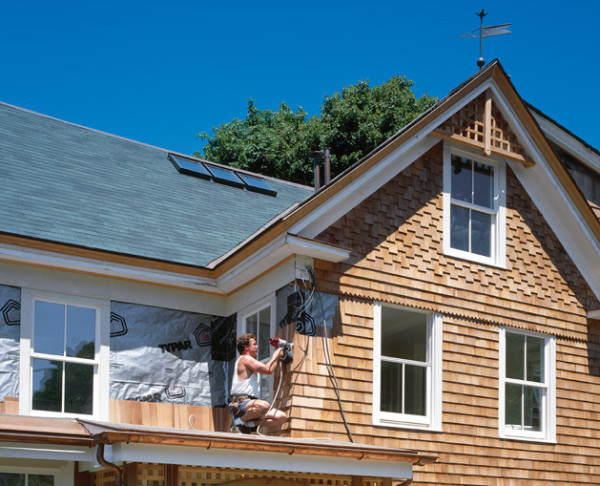
ELECTRICAL & LIGHTING
Still reaching American homes as late as the 1930s and ’40s, electrical wiring is a relatively new technology. Both wiring and electrical codes, also energy loads have evolved rapidly ever since to make this modern essential both safe and more efficient.
Knob and tube wiring found in many early 20th century houses is quaint but obsolete.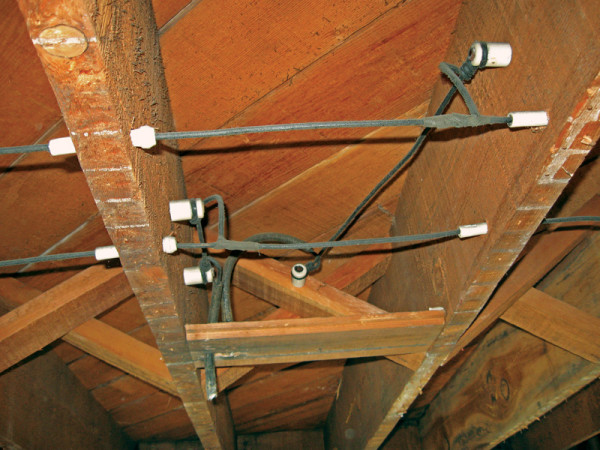
Knob & Tube Wiring {replace}
It’s quaint, it’s historic, and it’s hazardous. Common in homes built between roughly 1880 and the 1940s, knob and tube gets its name from the chunky ceramic knobs and slender tubes that connect the wiring and snake it through wall and ceiling joists.
Knob and tube should be replaced with new wiring that meets modern electrical codes for good reason. First, it’s ungrounded, making it both a shock and fire hazard. Next, any remaining insulation on the wiring is likely to be disintegrating or completely gone, exposing live copper wires. Further, this obsolete wiring isn’t designed to carry today’s high electrical loads. Most home insurance won’t cover a house with known knob and tube wiring, and modern building codes prohibit altering it, requiring full replacement.
A vintage chandelier, restored and sold by Historic Houseparts.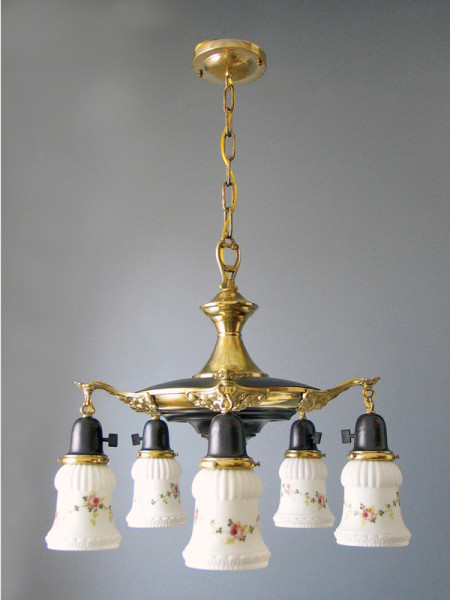
Original Light Fixtures {save}
Whether still hanging or in storage, finding a light fixture that dates to the build date of your home can be a thrilling moment for an old-house lover. However, not all light fixtures go back as far as the house. Some may not be very appealing, but they are technically part of the house’s history.
That’s a good reason for saving any fixture with a few decades of age on it. Store it properly in a box in the basement or attic for a future owner to discover. If the light is clearly inappropriate for the house style-wise, sell it to a salvage dealer or at an online auction. Someone is probably combing eBay for a fixture just like it.
The wiring in Sundial Wire’s cloth-covered cord is coated with PVC insulation to meet modern electrical codes.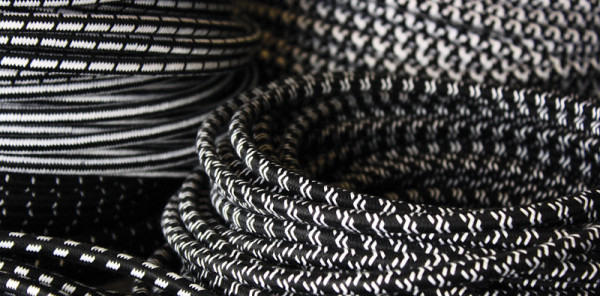
Vintage Lamp Cords {replace}
Cloth-covered lamp cords on vintage table and floor lamps (and occasionally fixtures like pendants) evoke instant nostalgia, but many from the first half of the 20th century contain asbestos. Like the insulation on knob and tube wiring, the old cloth covers tend to wear and fray over the decades,exposing live wires. Fortunately, there’s a good-looking solution: modern cloth-covered cording that not only resembles period lamp wire, but is also safe and meets modern codes.
A “push button” dimmer switch from Classic Accents.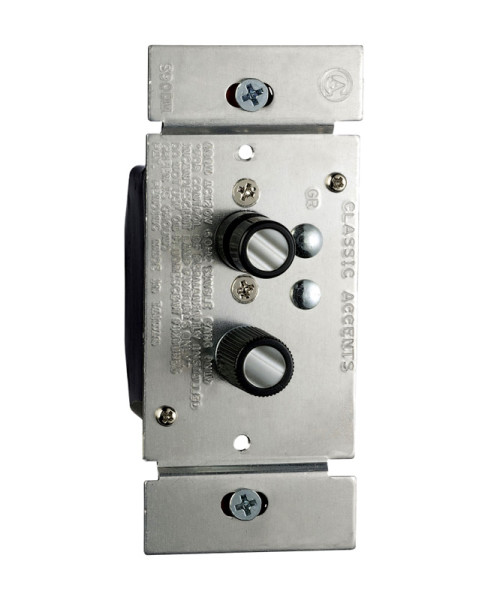
Push Button Light Switches {save and partially replace}
Love your old push-button light switches but worry about electrical hazards? Simply remove the cover and replace the electrical box underneath with a new one that meets code. (Check with an electrician to make sure your wiring will support the new fixture.) You can even update the works with dimmer switch knobs finished with synthetic mother-of-pearl inlay. Keep or sell the old knobs for craft projects.
HARDWARE
Household hardware—for doors, windows, and cabinets— ranges from highly prized to despised. Old hardware may be missing, broken, or coated with paint. That’s no reason to throw it away, however.
This oversized window sash lift was reproduced by Crown City Hardware from a historic Los Angeles building.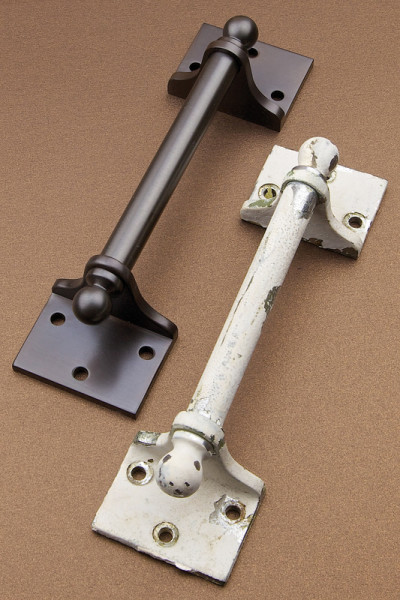
Missing Hardware {replace or replicate}
There’s generally no alternative for missing or badly damaged door hinges, cabinet pulls, or doorknobs except replacement. Before you launch an online search for new hardware, however, consider your options. The first is to seek out salvage hardware that closely resembles the missing piece or broken parts. There are dozens of online salvage dealers from which you can source knobs, plates, and pulls common a century or so ago. Beyond eBay.com and etsy.com, check out American Historic Hardware, a specialist in unused, new old-stock hardware from the late 19th and early 20th centuries.
The second is to find new hardware that closely matches what’s missing in style, scale, materials, and finish. Ironically, many reproductions of common early 20th-century hardware are made from heavier stock and better quality materials than the originals. (Something called “pot metal” was commonly used for back plates.) Start by consulting the offerings of restoration specialty retailers.
For fine or irreplaceable hardware, replication is an option. Vintage Hardware & Lighting is one of several vintage hardware specialists that can replicate knobs and handles by making castings from an original example. Mechanical hardware (a locking mechanism, for instance) is much more challenging and expensive to re-create, however, because doing so requires making steel dies to create the working parts.
An early 19th-century interior, treated to a palette of milk-paintcolors in earth tints, from Olde Century Colors.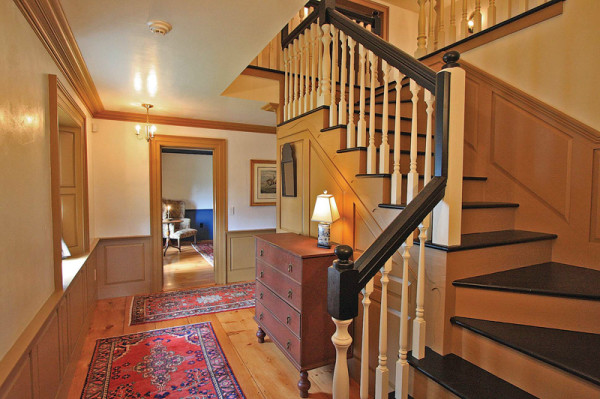
Painted Hardware {save}
Old hardware in working or repairable condition should always be saved. If an escutcheon plate or lock strike is so heavily coated with paint it interferes with the operation of the door or window, remove it and treat it to a hot bath. First, score around the plate with an X-acto knife to loosen the paint’s bond with the wood underneath. Use a blunt-head screwdriver to scrape away any paint covering the mounting screws.
Once removed, treat the piece to a hot bath to which you’ve added a few tablespoons of dishwashing liquid. Use an old crockpot, or an old kettle no longer used for cooking, heated up to a simmer. Over the course of a few hours, the hot-water bath should loosen the paint enough that it can be pried off easily. Once cool, scrub the surface with a nylon (not wire) bristle brush to remove any stubborn paint. Freshen up the surface with a coating of beeswax, buffed with a soft cloth.
‘Georgetown Medallion’ was recreated by Adelphi Paper Hangings from small fragments found during a renovation.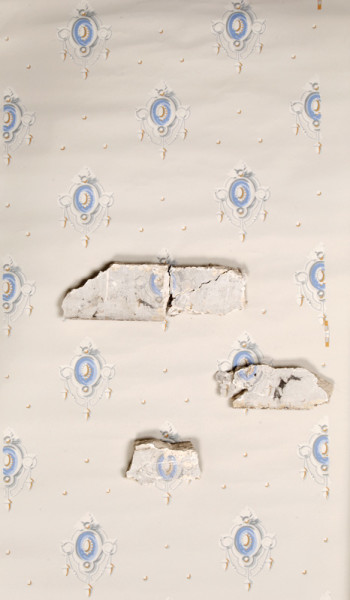
WALLPAPER & PAINT
Wallpaper is notoriously messy and time-consuming to strip, so many older houses tend to have multiple layers applied one over the other, creating a wallpaper time capsule.
Original Wallpaper {save}
Leave at least a small area where all layers are intact. This should serve as an important reference to a future owner/restorer. Good places to leave an untouched sample include inside a closet or underneath a cabinet or wall-hung piece of furniture.
{replace or replicate} If you can find a reproduction wallpaper that’s similar to one of the layers in your house, use it. More often than not, however, it’s impossible to find an exact match for a historic pattern, even one from the early 20th century. (Wallpaper companies have been phasing out and “updating” patterns every few years since machine-printed papers became widely available in the late 19th century.) Consult a restoration wallpaper specialist who offers papers from the era of your house.
If the house is especially old or historically significant, consider replicating one of the period papers. Like any kind of custom work, this will entail extra costs, but part of the appeal of this exacting process is the ability to specify a custom colorway or make other changes suited to personal taste.
Closely matched to original colors found in the attic, Sherwin-Williams’ ‘Rachel Pink’ and ‘Classic Ivory’ grace the walls and flush-built cabinets in a near-perfect restoration of a 1712 Colonial. (Photo: Edward Addeo)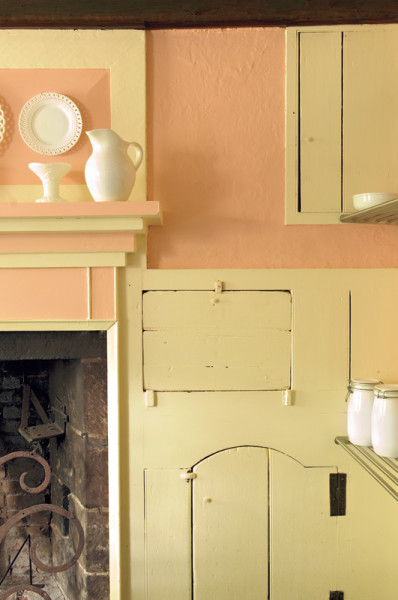
Old Paint Colors {restore}
Matching new paint to old is an inexact science. The best method is to take a chip of the old paint to a good paint or hardware store and ask them to match it. An experienced paint mixer should be able to tell whether the paint is oil- or water-based, and come up with a blend that closely matches the sample. To test, paint swatches on several exposures to see how closely the new paint matches in different lights.
{replace} If the paint is so worn that it’s impossible to retrieve a sample, consult a historic paint color chart for true-to-period options. Many major brands publish historical color charts, as do milk paint companies. Once a ground color is chosen, apply test swatches, then pair them with possible trim paint colors. Subtle differences in the tints added to paint can skew how the paint will appear in the context of another color, sometimes disastrously. Keep tweaking the pairings until you get a pleasing combination. If you lack the patience for this, consult a paint specialist.
Match replacement tile closely to the old, including details like tight grout lines.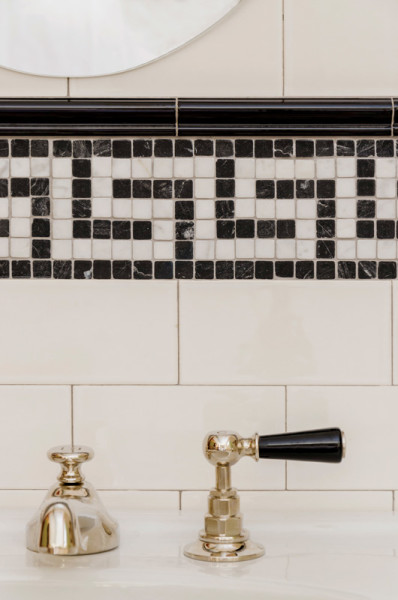
BATH & KITCHEN
Original Tile Nothing makes a bathroom or kitchen backsplash look more authentic than original period tile. It’s a rare tile wall that survives intact over a period of 70 years or more, however, as tiles can break, suffer water damage, or be fully or partially removed.
{restore} or {replace} If only a few tiles are damaged or heavily discolored, it’s possible to replace them with new tile of similar size, color, and finish. Early 20th-century hexes, penny rounds, and “subway” tiles are available from at least two sources, in both glazed and unglazed finishes and multiple colors.
Make sure the replacement tile matches in all details: size (width x length x depth), square edge or round edge. Install on a clean substrate and follow the manufacturer’s instructions, taking care to butt the tile closely to surrounding tile using grout lines as narrow or wide as the rest of the tile.
Period bath and kitchen sinks and tubs are much prized by historic house hunters, but they’re not always in good condition and, in the case of mid-century fixtures, not always to contemporary tastes.
Original Fixtures {save} {restore} or {replace}
Cast-iron bathtubs and vitreous enamel sinks from the era of the house should be saved unless the porcelain is rusted through or seriously cracked. Give any suspect fixture a thorough cleaning (Bon Ami and a sponge or soft plastic bristle brush work well without damaging the surface).
If the enamel finish is worn through in spots but the fixture is in otherwise good condition, have it reglazed by a professional who uses a two-part acrylic polyurethane resin coating that resembles the original enamel in shine and appearance. The work should be guaranteed to last at least five years. Whether done in your home or in a shop, the process requires etching the fixture to allow the new enamel to bond with the tub, sanding and filling nicks and abrasions, and multiple coats of finish.
If you’ve inherited bath or kitchen fixtures from a much later era, consider saving them as part of house’s history if they are in good condition. If not—or if the colors are hideous in context or taste—replace them. Offer any fixtures in good condition to a salvager, or sell them online. Someone else may want a yellow bathroom sink or jade-green bathtub.
Ornate brass taps on a marble washstand in a 1901 child’s room preserve character at Locust Grove, an A.J. Davis Italian Villa. (Photo: Gross & Daley)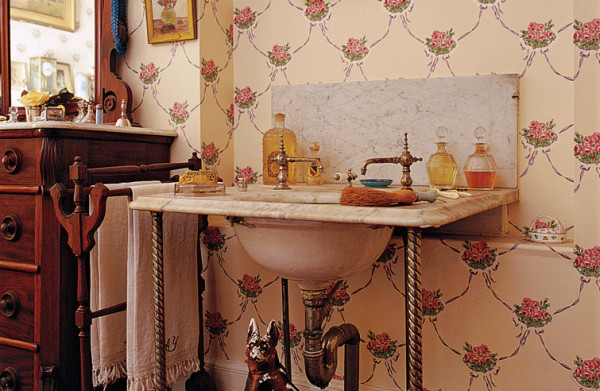
Faucets & Fittings
Old houses are replete with faucets and tub fillers that still work even though they don’t meet modern building codes or contemporary preferences. If you are contemplating plumbing work in either location, however, you may want an alternative that looks and works much like what’s already there.
Separate Cold and Hot Taps {save} {restore} or {replace}
Many small, early 20th-century sinks are equipped with these non-mixing taps. If you don’t mind the inconvenience and the taps are in good condition, keep them. If they’re in poor condition, rusty, or need replating, replace them, either with a mixing tap or two separate reproduction taps. In the first instance, the extra hole can be filled with a plug. Or install a period-look soap dispenser in place of the old tap.
A reproduction standing waste tower fixture from Sign of the Crab functions perfectlyand fits all the right openings in a vintage tub.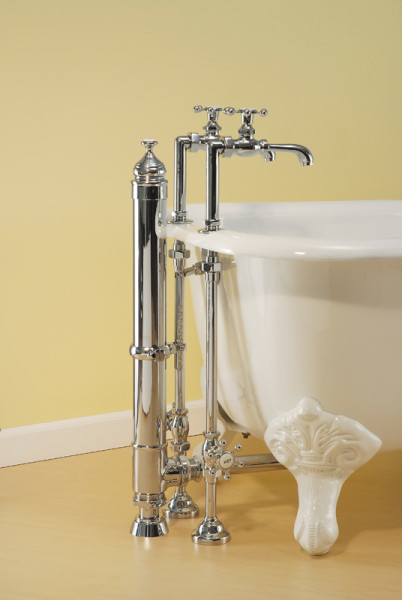
Standing Waste Tub Fillers {restore} or {replace}
Original standing waste tub fillers are considered obsolete because they don’t meet modern plumbing codes in terms of water flow and waste disposal. They’re also prone to leaks and other damage that makes them difficult to repair.
A few bath-salvage specialists will restore vintage standing waste drains. The service isn’t cheap, but it’s less than the cost of a replacement tower fixture. Bathroom Machineries, for instance, takes the entire assembly apart and inspects it for cracks, breaks, and wear. Every piece is cleaned and sandblasted; irreparable parts are machined new. All parts are then polished and either lacquered or freshly replated. The entire fixture is then reassembled with new seals and gaskets, then water tested.
If the waste is too far gone for repair (or too distant from a good restorer), there are now sources for replacements that not only meet code, but also are machined to fit the existing holes in the tub, which vary according to the original manufacturer.
Double-sided tongue-and-groove Heritage porch planks from Aeratis closely match the look of woodand promise greater longevity than many species of wood.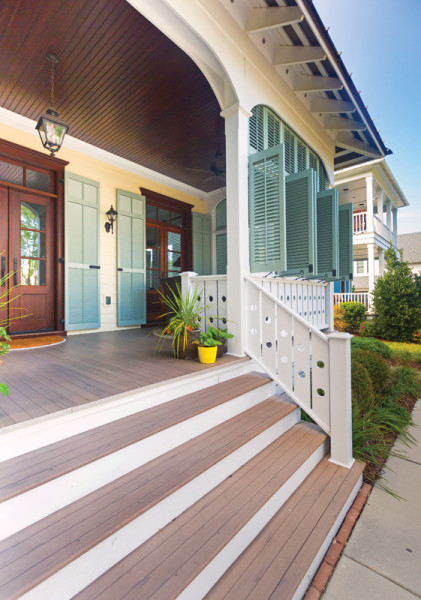
EXTERIOR MILLWORK
Exterior siding and trimwork that’s in sound condition should always be preserved, preferably with a fresh coat of paint or stain.
Rotted or DamagedClapboards {replace}
When wood is rotted or suffering from significant damage, it should usually be replaced. Use new wood that closely matches the dimensions, species, and grain of the old. Depending on the age of the house, its location, and whether the siding has been previously replaced, the grain may be either quarter-sawn or flat sawn.
Quarter-sawn siding (also called vertical grain) is cut radially from a single, tightly grained tree. The cutting method produces clapboards with a tight, horizontal grain that tends not to cup, shrink, crack, or swell.
In flat- or plain-sawn siding, the wood is initially cut straight through the log, across the growth rings rather than with them. The growth rings appear as curved lines running through the face of the board. Although top grades offer good longevity, plain-sawn wood is more likely to cup and change shape than vertical grain.
Quarter-sawn clapboards from Ward Clapboard Mill are cut radially from a single tightly grained log, yielding a vertical grain with great longevity.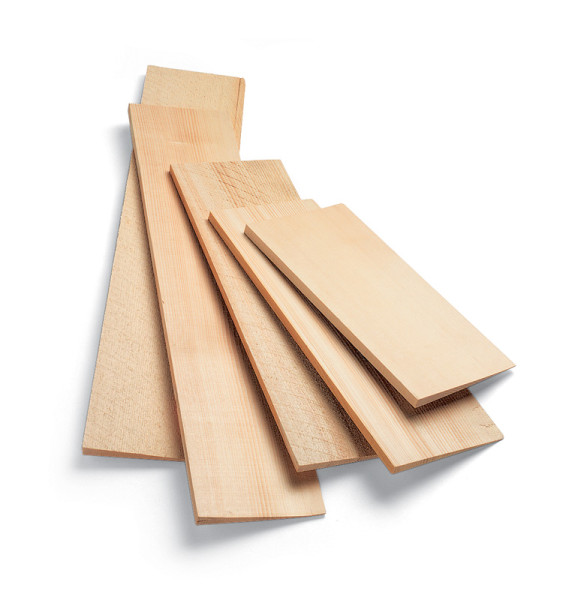
Damaged Porch Parts & Decorative Trim {repair} {replace} or {replicate}
Original turned and chamfered porch posts, porch floorboards, brackets, and corbels should be saved if they’re in good condition, especially if they’re made from old-growth wood. When decorative elements are too far gone, alternatives include replicating the originals in weather-resistant wood or long-lived composite materials.
Specialty companies offer corbels and assorted gingerbread in true-to-period designs. ProWood Market, for example, offers more than a dozen rafter tail profiles. When a rare piece of ornament is missing or damaged, a historic millwork specialist may be able to replicate it. Trace the outline of a surviving element, measuring every possible dimension. Send the tracing and measurements to your chosen company, and within weeks you should have a replica.
A Miracle for Wood
Built for a 1926 Italian Renaissance-style house, these Douglas fir doors had suffered heavy termite damage. The wood was pocked with tunnels and holes burrowed by active termites. Once the termite infestation was removed, CCS Restoration used two Abatron products to effect repairs. First, softened areas, tiny holes, and tunnels were firmed up using Liquid Wood. Larger voids and damaged profiles were rebuilt using WoodEpox.
HVAC Like plumbing and electrical systems, most heating, cooling, and ventilation systems are subject to technological obsolescence—with one exception.
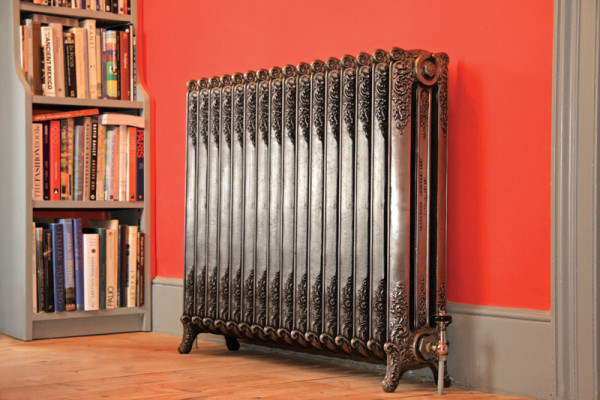
Steam or Hot Water Radiators {save}
While you will certainly have to replace a hot water or steam boiler every decade or so, the units that deliver the heat—one- or two-pipe radiators—can and will last for a hundred years or more. This is one case where something that’s quaint and historic is worth keeping over the long haul.







